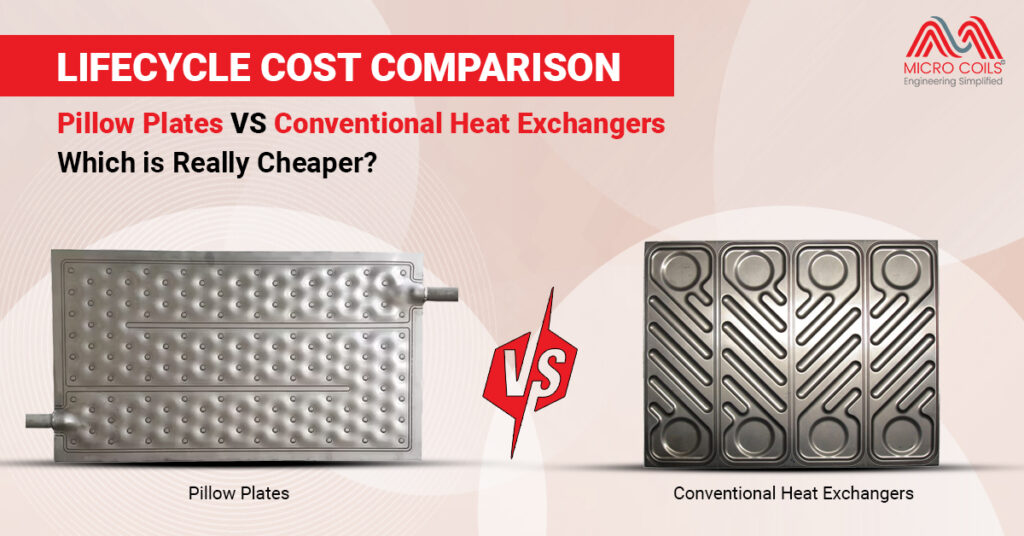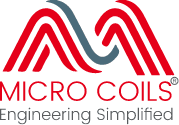
When you’re running a business that needs to heat or cool liquids, choosing the right heat exchanger can make a huge difference in your bottom line. It’s not just about the price you pay upfront – you need to think about all the costs over the entire lifetime of the equipment. Today, we’re going to break down the real costs of pillow plates versus conventional heat exchangers in simple terms, so you can make the best decision for your business.
What Are Heat Exchangers?
Before we dive into costs, let’s make sure everyone understands what we’re talking about. A heat exchanger is basically a device that transfers heat from one liquid to another without mixing them together. Think of it like a radiator in your car – hot engine coolant flows through it, and air blows over it to cool the liquid down.
In industrial settings, you might need to cool down hot chemicals, heat up water for processes, or maintain specific temperatures for manufacturing. Heat exchangers make all of this possible.
What are Pillow Plates?
Pillow plates are a newer type of heat exchanger that look exactly like their name suggests – they’re flat, rectangular plates that puff up like pillows when liquid flows through them. They’re welded together in a special pattern that creates channels for liquid to flow through while maintaining strength.
The design is simple but clever. Hot or cold liquid flows through these channels, and the large surface area allows for efficient heat transfer. They can be attached to tanks, used as standalone units, or built into various industrial processes.
Conventional Heat Exchangers: The Traditional Choice
Conventional heat exchangers come in many shapes and sizes, but the most common types are shell and tube exchangers, plate and frame exchangers, and finned tube exchangers. These have been the industry standard for decades and are well-understood by most engineers and maintenance teams.
These traditional units typically have more complex internal structures with tubes, plates, or coils that liquid flows through. While they work well, they often require more space and can be more complicated to maintain.
Initial Purchase Costs: The First Numbers You’ll See
When you first start shopping for heat exchangers, pillow plates often have a lower upfront cost compared to conventional systems. This is because they’re simpler to manufacture and require fewer materials. Pillow plate manufacturers have streamlined the production process, which helps keep initial costs down.
Conventional heat exchangers, especially larger shell and tube systems, typically cost more upfront because they require more complex manufacturing processes, more materials, and often custom engineering for specific applications.
However, don’t let the initial price tag be your only consideration. The real story comes out when you look at the total cost over many years of operation.
Installation Costs: Getting Them Up and Running
Pillow plates are generally easier and cheaper to install. They’re lighter, take up less space, and often require simpler piping connections. This means less labor time, smaller foundations, and reduced installation complexity. Your maintenance team can often handle the installation with basic tools and equipment.
Conventional heat exchangers, particularly large ones, may require cranes, special foundations, complex piping systems, and more skilled labor for installation. This can add significant cost to your project, especially if you need to modify your facility to accommodate the equipment.
Operating Costs: The Daily Expenses
This is where things get interesting. Pillow plates often operate more efficiently than conventional systems because of their design. The large surface area and thin liquid films mean better heat transfer, which can translate to lower energy costs for pumping and heating or cooling.
Conventional heat exchangers might require more pumping power to push liquids through complex tube systems or may not transfer heat as efficiently, leading to higher energy bills over time.
The efficiency advantage of pillow plates can add up to substantial savings over years of operation, especially in energy-intensive applications.
Maintenance Costs: Keeping Things Running
Here’s where pillow plates really shine. Their simple design means fewer things can go wrong. There are no complex tube bundles to clean, no intricate internal components to replace, and fewer gaskets or seals that might fail.
When maintenance is needed, pillow plates are typically easier to access and service. Many issues can be resolved without completely dismantling the system, which means less downtime and lower labor costs.
Conventional heat exchangers often require more frequent and complex maintenance. Tube cleaning, gasket replacement, and internal inspections can be time-consuming and expensive, especially if you need specialized technicians or equipment.
Durability and Replacement Costs
Both pillow plates and conventional heat exchangers can last many years with proper care, but their failure modes are different. Pillow plates tend to fail more predictably – when they do have problems, it’s usually obvious and localized.
Conventional systems might have more gradual degradation, with individual tubes or plates failing over time. While this might seem better, it can actually lead to higher long-term costs as you’re constantly repairing or replacing components.
Space and Infrastructure Costs
Don’t forget about the cost of the space your equipment occupies. Pillow plates typically have a much smaller footprint than conventional heat exchangers, which means you need less floor space and potentially smaller buildings or equipment rooms.
In facilities where space is expensive or limited, this can represent significant savings. You might be able to fit pillow plates into existing spaces where conventional units wouldn’t fit, avoiding costly building modifications.
Regional Considerations
If you’re operating in India, pillow plate manufacturers in India often provide cost advantages through local manufacturing and reduced shipping costs. This can make the initial cost difference between pillow plates and conventional systems even more favorable.
Local manufacturers also typically provide better service support, faster delivery of spare parts, and more competitive pricing for replacement units when needed.
Cooling Applications: A Special Case
For cooling applications, pillow plates can often work effectively without additional equipment like a dry cooler, depending on your specific needs. This can eliminate entire pieces of equipment from your system, reducing both initial costs and ongoing maintenance requirements.
Conventional systems might require additional cooling equipment, pumps, or control systems that add to the total system cost over its lifetime.
The Real Numbers: Putting It All Together
When you add up all the costs over a typical 15-20 year equipment lifecycle, pillow plates often come out significantly ahead. While the exact savings depend on your specific application, many businesses see total lifecycle cost reductions of 20-40% compared to conventional heat exchangers.
The biggest savings typically come from reduced maintenance costs, lower energy consumption, and decreased downtime. These operational savings often far exceed any difference in initial purchase price.
Making Your Decision
The choice between pillow plates and conventional heat exchangers isn’t just about money – you also need to consider your specific application requirements, available space, and technical capabilities. However, from a pure cost perspective, pillow plates offer compelling advantages for many applications.
The key is to look beyond the initial price tag and consider all the costs you’ll face over the equipment’s entire lifetime. When you do that math, pillow plates often prove to be the more economical choice, delivering better value for your investment while providing reliable, efficient operation for years to come.
Pillow plates are designed with multiple independent flow channels, so if one section gets damaged, the rest continues working. Repairs are typically straightforward since the damage is usually visible and localized, making it easier to patch or replace just the affected area without shutting down the entire system.
Yes, pillow plates can be engineered for various pressure requirements. The welded construction actually distributes pressure loads evenly across the surface. However, the maximum pressure capability depends on the specific design, materials used, and manufacturing quality, just like with any heat transfer equipment.
Pillow plates offer easier cleaning access since their flat surfaces can be cleaned externally, and internal cleaning uses simple flush procedures. Conventional systems often require disassembly for thorough cleaning, especially shell-and-tube designs where individual tubes need cleaning or replacement, making the process more labor-intensive.
Conventional heat exchangers may be preferred for extremely high-temperature applications, processes requiring very specific flow patterns, or situations where decades of proven performance data is crucial. Some specialized industries also have established standards that specifically call for conventional designs.
Minimal additional training is typically required since pillow plates have simpler operation procedures. Most operators find them more intuitive to monitor and maintain. The main learning involves understanding the different visual inspection points and recognizing that troubleshooting is often easier due to the straightforward design.





